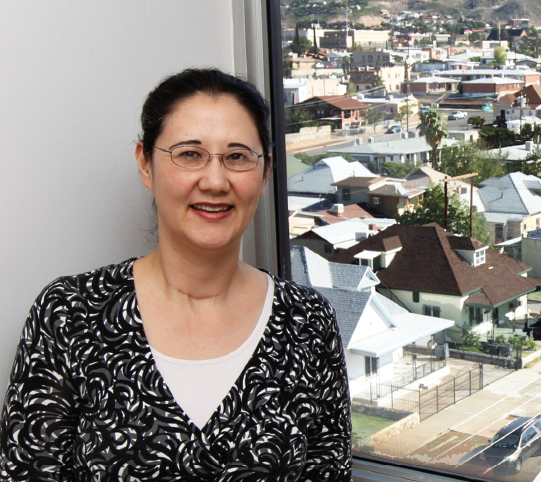Understanding that research is most effective when it leads to practical solutions and benefits for the community, UTEP’s College of Health Sciences is using a unique program to build strong partnerships with the region’s health organizations.
The Community and Academic Partnership for Health Sciences Research (CAPHSR), founded in 2009, brings together researchers and the individuals who work day-to-day in the community to improve the physical and mental health of residents – young and old – living along the U.S.-Mexico border.
The research projects of CAPHSR (pronounced “capture”) have placed emphasis on aging and chronic disease, mental health and substance abuse, children with special needs, and creating healthy homes.

“I very much believe in the power of universities working together with communities to change their health outcomes,” said College of Health Sciences Dean Kathleen Curtis, Ph.D. “We have an unlimited supply of student help, and the kinds of projects and activities that we can do with community partners are perfect for student learning and for integrating what they are learning about in classes with real life problems.”
Since the program’s inception, representatives from as many as 20 community organizations have met with health sciences faculty each month to network and build relationships. Participants also attend quarterly training workshops, where they polish research skills and work on community-based research projects.
In March, the College of Health Sciences awarded $4,000 Community and Academic Partnership mini-grants to six teams of faculty and community partners to conduct community-based participatory research projects that are aligned with Healthy People 2020 goals.
The grants provide seed money that allow participants to solidify their partnerships and collect pilot data to prepare grant proposals for outside funding, Curtis said.
One project is “Promoting the Health of Older Adults,” a collaboration between health sciences and liberal arts faculty, UTEP’s Center for Civic Engagement and El Paso’s City Parks and Recreation Department.
The service-learning project involves UTEP students who are developing a public health education campaign about the city’s annual Senior Games.
Another area focuses on children with special needs. Occupational Therapy Assistant Professor Eugenia Gonzalez, Ph.D., is working with the Department of Speech-Language Pathology, the Paso del Norte Children’s Development Center, Region 19 – Early Childhood Intervention, and the Ysleta Independent School District to conduct a survey to find out what screening tools pediatricians use to determine developmental delays in children, such as autism.
“We are working on measuring the number of children with autism spectrum disorders in our community, and early identification and referral protocols,” said Jaime Barceleau, executive director of Paso del Norte Children’s Development Center. “Our long-term goal is to improve services to this population.”
Barceleau has been involved with CAPHSR since the beginning.
“My involvement is consistent with my professional interests,” said Barceleau, a UTEP graduate. “I think the work of the University and CAPHSR is important because it has strengthened ties between UTEP and the community agencies, and it has gotten us to focus on common goals.”
Jeri J. Sias, Pharm.D., a clinical professor in the UTEP/UT Austin Cooperative Pharmacy Program, is working with Centro San Vicente, the Texas A&M Colonias Program and the Boys and Girls Club on a project concerning healthy homes for families and adolescents.
The team is conducting focus groups in two of the city’s low-income zip codes and in the Socorro community to find out what parents think about the quality of life and well-being of their neighborhoods.
Sias said CAPHSR goes beyond sharing information between the University and its community partners.
“Research should have meaning,” she said. “Research should lead to improved health in our communities.”
Mark Lusk, Ed.D., and Griselda Villalobos, Ph.D., in the Department of Social Work are working with Family Services of El Paso to study depression and trauma among Mexican refugees.
Eva Moya, Ph.D., assistant professor of social work, is recruiting 25 migrant women who are survivors of domestic abuse from Migrant Refugee Services, Familias Triunfadoras in San Elizario and the Mexican Consulate’s program, Ventanillas de Salud, to conduct a Photovoice project that focuses on women’s sexual and reproductive health.
João Batista Ferreira-Pinto, Ph.D., director of UTEP’s Center for Interdisciplinary Health Research and Evaluation in the College of Health Sciences, has worked with community partners in the past. But until CAPHSR, Ferreira-Pinto felt that the research was very one-sided.
“I’ve been on both sides of the fence. I was a researcher and then I started to work with community-based organizations,” he said. “I could see how there could be some apprehension from community organizations because some researchers go in, interview their patients, collect data and never share what they found. We get this data and people don’t know what happened.”
That data can only be provided by community organizations that work directly with the population, CAPHSR researchers said.
“Academics see health from a theoretical or literature point of view – we know how many people die from this and we’re very knowledgeable about the statistics,” Sias said. “But our partners deal with health issues every day. They’re our key informants as to what is practical and what patients will respond to, and it’s important that our partnership be two-sided.”
This fall, CAPHSR members will continue to work on their individual community projects but under a new unifying theme: Healthy Homes and Communities Across the Lifespan.
“One of the things that has come out of this partnership is that things evolve and emerge over time,” Sias said. “We’ve realized that we’re all connected because we’re all trying to do different research and educational programs that create a healthier home and a healthier community, so why not embrace that?”
Sias said that it will take time to see CAPHSR’s impact on the community.
“It’s a longer-term picture, but we have to make the investment,” she said. “It’s also the right thing to do. From an outside perspective, I think that people would expect UTEP and the community should be working together all along.”